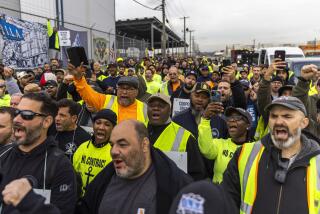Filling It Up, Shipping It Out : Volume of Container Exports Headed for Asia Is on the Rise
- Share via
Southern California’s biggest export by volume is not oranges, movies or missiles. It’s empty space. But that’s changing, and shipping companies say it is about time.
Close to half the containers that passed through the ports of Los Angeles and Long Beach last year left empty. But the fall in the U.S. dollar and the advent of advanced new ships, including the giant President Truman, which made its first visit to Los Angeles on Monday, is beginning to fill the 20- to 48-foot-long boxes for their return trip to East Asia. The rising volume of exports are welcome as the major transpacific shipping companies take delivery of more and bigger ships.
Both Oakland-based American President Cos. and Menlo Park, N.J.-based Sea-Land Corp., probably the two largest transpacific container ship operators, say their Asia-bound ships are setting out fully loaded from West Coast harbors. Ships bound for Asia are now operating closer to full capacity than ships moving east across the Pacific, said Bruce Seaton, American President’s chairman and chief executive. “Now the industry utilization westbound, export-wise, is greater than eastbound. So there’s no back haul (of empty containers).”
American President’s export traffic rose 35% in the first quarter of this year from the same period in 1987. But after five years of averaging 17% annual growth, imports are likely to grow just 6% in volume this year, Seaton predicted in an interview Monday. “I’m not sure even that is going to hold.”
Since the beginning of the year, American President has already posted two rate increases totaling about 10% for Asia-bound traffic. Freight rates for imports, by comparison, have actually fallen at several lines.
Yet rising exports have not been all good news for shipping companies because the kind of goods shipped has not changed. The United States continues to export the weighty, low-value commodities more commonly associated with underdeveloped nations. Commodity sales have risen because they are especially sensitive to falls in the price of the dollar, which make U.S. goods cheaper for overseas buyers. But scrap metal and lumber do not need the sort of premium service--such as providing customers with up-to-the-minute reports on where their products are--that shipping lines are increasingly geared to provide.
Last year, American President’s average charge for transporting a 40-foot container full of exports was 56% of its average charge for imports. “I don’t know what (shipping companies) get for a container of paper waste, but it sure as hell is inferior to what you get for a container of electronic goods,” said Walter Oates, a spokesman for the U.S. Maritime Administration.
Overall U.S. container trade showed a huge deficit last year, with $64 billion in exports and $157 billion in imports, Oates said.
Some air freight companies have begun to notice an increase in the value of goods exported, but shipping companies have not yet, Seaton said. “We’ve watched it very, very carefully, and we cannot see any basic trend changes.”
That has not stopped shipping lines from continuing with ambitious expansion plans. Sea-Land has added six ships in the Pacific Ocean this year, five of them based in Hawaii. American President, which operates only in the Pacific and Indian Oceans, brought into service four large container ships last year and is adding five giant so-called post-Panamax ships this year.
So named because they are the first container ships too wide to pass through the Panama Canal, post-Panamax vessels such as the President Truman are designed explicitly for the transpacific route. Longer than the battleship New Jersey but so wide that it resembles a glorified barge from a distance, the President Truman has space for the equivalent of 4,300 20-foot-long containers.
The wider hulls give the ships added stability, allowing them to carry better the heavy containers holding U.S. exports, Seaton said. Some westbound ships have had to haul empty containers because the weight of containers full of scrap metal threatened seaworthiness. The new ships also are faster and simpler to load and unload because not as much care is needed in placing and balancing the heaviest containers.
The Truman--and the four sister ships that will follow it--was assembled in West Germany. Their 57,000-horsepower, slow-speed engines, the largest internal combustion engines ever, were made in South Korea. Seaton said the ships “would cost three or four times as much to build in the United States. And the Americans just don’t have the technology to build slow-speed diesel engines.”
With the addition of the five post-Panamax ships plus the four large ships last year, American President increased overall capacity by 20% last year and 24% this year, and projects an increase of 17% in 1989. Coupled with ship purchases by its rivals, the expansion threatens to leave the shipping industry stuck with overcapacity and high fixed costs if the U.S. economy falls into a recession next year, said Charles R. Bureker, an analyst with Sutro & Co. in San Francisco. “You could have some real capacity problems developing next year.”
West Coast Containerized Exports
Fourth quarter, 1987
Product/TEUs*
Waste paper 66,000
Logs and raw lumber 33,000
Cotton 30,000
Animal feed 23,000
Fruit 20,000
Resin 17,000
General cargo 13,000
Vegetables 13,000
Meats and poultry 12,000
Wood pulp 9,000
Hides 8,000
Aluminum scrap 8,000
Nuts 7,000
Mixed metal scrap 6,000
Cardboard boxes 6,000
Field seeds 6,000
Lumber boards 5,000
Borax 5,000
Newsprint 4,000
Benzenoid chemicals 4,000
West Coast Containerized Imports
Fourth quarter, 1987
Product TEUs
Wearing apparel 46,000
Auto parts 39,000
Furniture 37,000
Footwear 36,000
Toys 21,000
Television equipment 20,000
Computers 15,000
Tires 14,000
Bicycles 10,000
Misc. electrical products 10,000
Misc. plastic products 9,000
Cooking ware, irons, heaters 9,000
Hardware 9,000
Misc. machinery 8,000
Engine motors 8,000
Radios and stereos 7,000
Canned foodstuffs 7,000
Beer and ale 7,000
Motorcycles 7,000
Automobiles 6,000
* A TEU is a “20-foot equivalent unit.” A 40-foot container, for example, holds two TEUs.
Source: Port of Long Beach
More to Read
Inside the business of entertainment
The Wide Shot brings you news, analysis and insights on everything from streaming wars to production — and what it all means for the future.
You may occasionally receive promotional content from the Los Angeles Times.










